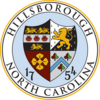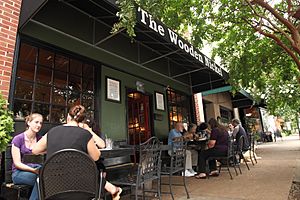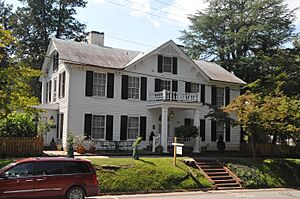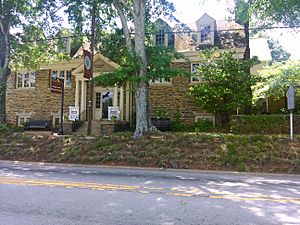Hillsborough, North Carolina facts for kids
Hillsborough is a town in Orange County, North Carolina, United States. It's the main town for the county and is located along the Eno River. In 2010, about 6,087 people lived here, but by 2020, the population had grown to 9,660.
For a long time in the 1800s, people unofficially called the town "Hillsboro." But in the late 1960s, residents voted to change the name back to its original, historic spelling: Hillsborough.
Quick facts for kids
Hillsborough, North Carolina
|
||
|---|---|---|
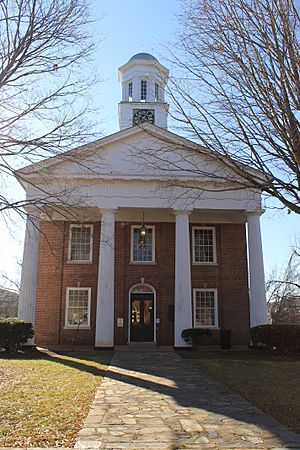
Old Orange County Courthouse
|
||
|
||
| Motto(s):
"Around the Corner, Ahead of the Curve." - Orange County Motto
|
||

Location of Hillsborough, North Carolina
|
||
| Country | United States | |
| State | North Carolina | |
| County | Orange | |
| Named for | Wills Hill, 1st Marquess of Downshire | |
| Area | ||
| • Total | 5.67 sq mi (14.67 km2) | |
| • Land | 5.59 sq mi (14.49 km2) | |
| • Water | 0.07 sq mi (0.19 km2) | |
| Elevation | 614 ft (187 m) | |
| Population
(2020)
|
||
| • Total | 9,660 | |
| • Density | 1,726.85/sq mi (666.76/km2) | |
| Time zone | UTC-5 (Eastern (EST)) | |
| • Summer (DST) | UTC-4 (EDT) | |
| ZIP code |
27278
|
|
| Area code(s) | 919 | |
| FIPS code | 37-31620 | |
| GNIS feature ID | 2405840 | |
| Website | www.ci.hillsborough.nc.us | |
Contents
History of Hillsborough
Native American Life in Hillsborough
For thousands of years, Native American groups lived in the Hillsborough area. A very old path, called the Great Indian Trading Path, crossed the Eno River here. Tribes like the Occaneechi and the Eno lived in this area when Europeans first arrived.
In 1701, an English explorer named John Lawson visited "Occaneechi Town" in this spot. Sadly, many tribes lost people due to new diseases brought by Europeans. Conflicts with other Native American groups also caused losses. Most survivors eventually had to leave their land.
English settlers built Hillsborough near where the Occaneechi village used to be. In the early 1700s, some Occaneechi moved to Virginia, but they returned around 1780.
In the 1980s, archaeologists from UNC-Chapel Hill found an old Occaneechi farming village here. Today, you can see a replica of an Occaneechi village near the Eno River.
Colonial Times and the Revolutionary War
Hillsborough was started in 1754. William Churton, a surveyor for Earl Granville, first mapped it. It was first called Corbin Town, then Childsburgh, before finally being named Hillsborough in 1766. It was named after Wills Hill, a British official.
Hillsborough was an important town in the Piedmont region. It was a place where courts were held. Before the Revolutionary War, there were some problems here. In the late 1760s, farmers in the Piedmont region were upset with county officials. This led to the Regulator movement.
Farmers found it hard to pay their taxes and didn't like it when their property was taken. Some local sheriffs even kept taxes for themselves. The governor, William Tryon, also spent a lot of money building a new mansion. This made the farmers even angrier.
Because the western areas didn't have enough representatives in the government, farmers couldn't get their problems fixed. So, they took action and closed the court in Hillsborough. They even pulled officials they thought were corrupt through the streets.
Governor Tryon and his troops marched to the area and defeated the Regulators at the Battle of Alamance in May 1771.
The North Carolina Provincial Congress met in Hillsborough from August to September 1775, right at the start of the American Revolution. The North Carolina government also met here in 1778, 1782, and 1783.
Hillsborough was also where North Carolina held its first meeting to decide whether to approve the Constitution. This meeting happened from July 21 to August 2, 1788. The delegates voted to neither approve nor reject the Constitution. They hoped to add a Bill of Rights first. A historical marker now stands at the site of this important meeting.
William Hooper, who signed the Declaration of Independence, was first buried in Hillsborough. Later, his remains were moved to Guilford Court House Military Battlefield. His original gravestone is still in the town cemetery.
Civil War and After
The Burwell School was a girls' academy run by Robert and Margaret Anna Burwell from 1837 to 1857.
When the Civil War started, many people in Hillsborough didn't want to leave the Union. However, many men from the town fought for the Confederacy. In March 1865, Confederate General Joseph E. Johnston and his soldiers stayed just outside Hillsborough at the Alexander Dickson home. This house was later moved downtown to save it and is now the Hillsborough Welcome Center.
After his famous "March to the Sea," Union General William T. Sherman was camped in Raleigh. He offered to meet Johnston to discuss ending the war. Johnston, coming from Hillsborough, and Sherman, coming from Raleigh, met at the home of James and Nancy Bennett, near what is now Durham. This farmhouse is now called Bennett Place.
The two generals met three times in April 1865. On April 26, they agreed on the final terms of surrender. Johnston surrendered 89,270 Southern troops. This was the largest surrender of troops during the war and effectively ended the conflict.
Historic Places to Visit
Hillsborough has many historic sites, some from the late 1700s. More than 100 buildings from the late 1700s and 1800s still stand, showing the town's important history.
You can also find old buildings, bridges, and mill sites along the Eno River. Native American artifacts have been found from ancient villages that are thousands of years old.
Alexander Dickson House
The Hillsborough Visitors Center is located in this house from the late 1700s. It was moved from its original spot 1 mi (1.6 km) southeast of Hillsborough. The site also has an office used by Confederate General Joseph E. Johnston.
Old Orange County Courthouse
The Old Orange County Courthouse was built in 1844. It's a Greek-revival style building designed by John Berry. The courthouse is still used for legal business today.
The Hillsborough Clock on top of the courthouse is from the 1760s. People once thought it was a gift from King George III, but its true origin is unknown. It was first in the town church, then moved to the Market House. In 1781, during the war, the clock's bell was thrown into the Eno River. But it was found, fixed, and put in the courthouse. It still works today, over 250 years later! It's one of the five oldest working tower clocks in the USA.
Ayr Mount
Ayr Mount is a large house built in 1815. It has been restored and decorated with old furniture and art from that time. The property also has a 1 mi (1.6 km)-long walking path called the Poet's Walk.
Green Hill
Green Hill is another large house built between 1750 and 1784 for George Johnston. It was moved in the late 1960s from its original location about 12 miles south of Hillsborough.
Parks-Richmond House (The Inn at Teardrops)
This house gets its name from the teardrop-shaped glass on its front doors. Edmund Fanning owned the property until 1768, when he sold it to Thomas King, who ran an inn.
The main part of the house today might be King's old inn. Other important owners from the 1700s included General Thomas Person and John Taylor. In 1938, the J.W. Richmond family bought the house and made it their home. After more updates, it became 'The Inn at Teardrops', a bed and breakfast.
Margaret Lane Cemetery
The Margaret Lane Cemetery, sometimes called the Old Slave Cemetery, was first mentioned in records in 1885. It's believed that Peter Brown Ruffin bought the two 1-acre (0.40 ha) lots in 1854 to use as a burial ground.
Historic Occoneechee Speedway Trail
Occoneechee Speedway, just outside Hillsborough, was one of the first two NASCAR race tracks to open in 1949. It was a dirt track. It's one of only two tracks left from NASCAR's first season, the other being Martinsville Speedway. Today, the old track is a walking trail.
The Historic Occoneechee Speedway Trail (HOST) is a 3 mi (4.8 km)-long trail on 44 acres (180,000 m2) where the Speedway used to be. Bill France, who helped start NASCAR, wanted to build a 1 mi (1.6 km) oval track in Hillsborough. But local religious leaders didn't want it there. So, NASCAR officials moved their plans to Alabama and built the large Talladega Superspeedway in Talladega instead.
Poplar Hill
A former house called Poplar Hill, once owned by Julian Carr, is in the town's historic district. It was moved in 1980 from its original spot south of the Eno River.
National Register of Historic Places
Many other properties in Hillsborough are listed on the National Register of Historic Places. This means they are important historical sites.
Some of these include the Bellevue Manufacturing Company, Burwell School, Cabe-Pratt-Harris House, Commandant's House, Eagle Lodge, Eno Cotton Mill, Faucett Mill and House, Hazel-Nash House, Heartsease, Holden-Roberts Farm, Jacob Jackson Farm, Montrose, Moorefields, Murphey School, Nash Law Office, Nash-Hooper House, Rigsbee's Rock House, Ruffin-Roulhac House, Sans Souci, St. Mary's Chapel, and St. Matthew's Episcopal Church and Churchyard. The entire Hillsborough Historic District is also on the list.
Geography and Nature
Hillsborough is located along the Eno River. The town has built the Riverwalk, a paved path along the river. It's about two miles long and connects to trails in the Occoneechee Mountain State Natural Area and the Occoneechee Speedway trail. The Riverwalk is also part of the longer Mountains-to-Sea Trail.
According to the United States Census Bureau, the town covers about 4.6 square miles (12 km2) of land. Only a very small part, 0.22%, is water.
The stone used to build many buildings at nearby Duke University comes from the Hillsborough Quarry. This stone is sometimes called Duke Stone. It was used in the design of almost every building on Duke University West Campus.
Population Information
| Historical population | |||
|---|---|---|---|
| Census | Pop. | %± | |
| 1800 | 474 | — | |
| 1850 | 582 | — | |
| 1860 | 751 | 29.0% | |
| 1870 | 809 | 7.7% | |
| 1880 | 781 | −3.5% | |
| 1890 | 662 | −15.2% | |
| 1900 | 707 | 6.8% | |
| 1910 | 857 | 21.2% | |
| 1920 | 1,180 | 37.7% | |
| 1930 | 1,232 | 4.4% | |
| 1940 | 1,311 | 6.4% | |
| 1950 | 1,329 | 1.4% | |
| 1960 | 1,349 | 1.5% | |
| 1970 | 1,444 | 7.0% | |
| 1980 | 3,019 | 109.1% | |
| 1990 | 4,263 | 41.2% | |
| 2000 | 5,446 | 27.8% | |
| 2010 | 6,087 | 11.8% | |
| 2020 | 9,660 | 58.7% | |
| 2021 (est.) | 9,716 | 59.6% | |
| U.S. Decennial Census | |||
Hillsborough Population in 2020
| Race | Number | Percentage |
|---|---|---|
| White (not Hispanic) | 6,076 | 62.9% |
| Black or African American (not Hispanic) | 1,786 | 18.49% |
| Native American | 34 | 0.35% |
| Asian | 216 | 2.24% |
| Pacific Islander | 2 | 0.02% |
| Other/Mixed | 559 | 5.79% |
| Hispanic or Latino | 988 | 10.23% |
In 2020, the town had 9,660 people living in 2,739 households. There were 1,668 families.
Arts and Culture
Art Galleries and Museums
- Eno Gallery: A gallery that shows modern fine art.
- Hillsborough Gallery of Arts: A gallery run by artists themselves.
- Hillsborough Arts Council Gallery
- Orange County Historical Museum: This museum was started in 1956 to save and share the history of Hillsborough and Orange County.
Hillsborough is also home to the Music Maker Relief Foundation, an arts group known around the world.
Education in Hillsborough
Hillsborough is part of the Orange County School District. This district includes several elementary schools (River Park, Efland Cheeks, Grady A. Brown, New Hope, Pathways, Central, and Hillsborough), middle schools (A.L. Stanback, Orange, and Gravelly Hill), and high schools (Cedar Ridge High School and Orange High School).
Hillsborough also has charter schools like Eno River Academy (K-12) and The Expedition School (K-8). Partnership Academy (9-12) is an alternative school. Durham Technical Community College also has a campus in Hillsborough.
Famous People from Hillsborough
Hillsborough has many nationally known artists and authors for its size. Some of these include Lee Smith, Jill McCorkle, Allan Gurganus, Michael Malone, Annie Dillard, Hal Crowther, Frances Mayes, and David Payne.
Other notable people include:
- George B. Anderson (1831–1862), a Confederate general in the Civil War.
- Thomas Hart Benton (1782–1858), a U.S. Senator from Missouri.
- Armistead Burwell (1839–1913), a judge on the North Carolina Supreme Court.
- Minerva Ruffin Cain Caldwell (1820–1890), a First Lady of North Carolina.
- Kizzmekia Corbett (born 1986), a scientist who works on coronavirus vaccines.
- Margaret Mordecai Jones Cruikshank (1878–1955), the first female president of St. Mary's Junior College.
- John Dee Holeman (1929–2021), a Piedmont blues musician.
- William Hooper (1742–1790), a lawyer and politician who signed the Declaration of Independence.
- Michelle Jin (born 1974), a professional bodybuilder.
- Elizabeth Keckley (1818–1907), a dressmaker and friend of Mary Todd Lincoln.
- Doug Marlette (1949–2007), a cartoonist and author.
- Elizabeth Matheson (born 1942), a photographer.
- Logan Pause (born 1981), a soccer player.
- Hilda Pinnix-Ragland, a business executive.
- Connie Ray (born 1956), an actress.
- Scott Satterfield (born 1972), a college football coach.
- Billy Strayhorn (1915–1967), a jazz composer and pianist.
- Shepperd Strudwick (1907–1983), an actor.
- Bryse Wilson (born 1997), a Major League Baseball pitcher.
- Trenton Gill (born 1999), an NFL punter.
- Ronnie Warner (born 1965), an actor, writer, and director.
See also
 In Spanish: Hillsborough (Carolina del Norte) para niños
In Spanish: Hillsborough (Carolina del Norte) para niños


